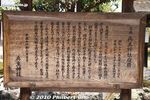Hyozu Taisha Shrine 兵主大社
|
Title   • File Name • File Name   • Date • Date   • Position • Position   |
|

Hyozu Taisha is amid rice paddies. The row of pine trees in the distance marks the path to the shrine. This is the view from the bus stop.
|
|

Front torii gate of Hyozu Taisha Shrine. MAP
|
|

After the front torii, there is a 300-meter gravel path lined with pine trees.
|
|

Then turn left to see the Taikobashi Bridge and red torii.
|
|

After the red torii is this red Romon Gate, said to have been donated by Shogun Ashikaga Takauji. The shrine also has historic ties to Minamoto Yoritomo and the Tokugawa shoguns.
|
|

Pass through the Romon Gate and this 100-meter path goes straight to the shrine's Haiden Hall.
|
|

Established in 717 (Nara Period), Hyozu Taisha worships a god named Onamuchi-no-Mikoto (大己貴命) also called Yachihoko (八千矛神). Onamuchi-no-Mikoto is a god of nation-building, farming, business, and medicine.
|
|

Hyozu Taisha Shrine. It worships the same god as Izumo Taisha in Shimane Prefecture. Yachihoko is known as the god of military strength. Japan's famous warriors desired this god's blessings and so patronized this shrine.
|
|

Monument for used and broken needles.
|
|

About Hyozu Taisha's Japanese garden. The garden dates back to the Heian Period. It was here even before the shrine moved here. The original garden was built by a local aristocrat named Harima-no-Kamisukeyori 播磨守資頼 who lived here in the Kama
|
|

Hyozu Taisha's Japanese garden, nationally noted as a famous garden. 兵主大社庭園
|
|

This garden is also beautiful in fall when they light up the autumn leaves at night (see photos below).
|
|
|
|
|
|
|
|
|
|
|
|

Torii and gate at night
|
|

Path to shrine
|
|

Hyozu Taisha Shrine at night
|
|
|

Hyozu Taisha Shrine's Japanese garden at night in fall. It's really beautiful. Like someone painted colorful autumn leaves on a black canvas.
|
|
|
|

Mini concert at night. They had a few solo musicians playing romantic night songs like Twinkle, Twinkle Little Star. Very nice.
|
|
|
|
|
|
|
|
|
|

Romon Gate at night in fall.
|
|
|
|
|